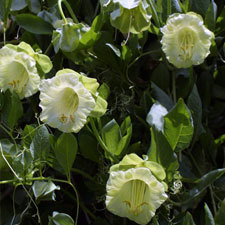 Cathedral bells
Cathedral bells
Common name: Cathedral bells, cup and saucer vine
Botanical name: Cobaea scandens
Management programme: Sustained control - Rule 5a applies
Native to Central and South America and introduced to New Zealand as an ornamental garden plant. It is also called cup-and-saucer vine as the flowers resemble tea cups and the base of the flower looks like a saucer.
Why is it a pest?
- It smothers other plants and prevents the establishment of seedlings.
- The vines are long-lived and can grow over trees and shrubs forming a dense canopy, smothering native plants.
- Seeds are wind dispersed, although it is believed that majority of the spread of cathedral bells is due to illegally dumped vegetation.
Where is it found?
This plant has been recorded in Rotorua and Tauranga.
Most likely to invade habitats such as open and intact forest and forest margins, coastlands, shrublands, especially in low frost areas.
What does it look like?
- Fast growing evergreen climber up to 6m, with strong tendrils and a scrambling habit.
- Angled stems have hook-like tips.
- Flowers are green and smelly when young, then turn deep purple as they mature. Flowers from September to May.
- Green seed capsule containing winged seeds is 5-9cm in length.
What are the rules?
Sustained control
Sustained Control pests are well established in the region and preventing the spread is no longer a realistic objective. Management focuses on reducing general impacts of the pest. Landowners/occupiers are responsible for the control of these pest species on their land. Council may enforce control.
Under rule 5a of the RPMP landowners/occupiers must destroy this pest if required by a written direction from an authorised person unless a property specific pest management agreement has been agreed and signed between the occupier and the Council.
Criteria to meet Rule 5A include when the species is being actively managed by council, other agency and or community group, on an adjacent property. See the Regional Pest Management Plan 2020-2030 rules for Sustained control pests for more information.
How do you get rid of it?
Recommended:
- Dig out scattered plants.
- Cut and paste large stems with herbicide.
- Spray in spring to summer with herbicide.
CAUTION: When using any herbicide or pesticide, PLEASE READ THE LABEL THOROUGHLY to ensure that all instructions and directions for the purchase, use and storage of the product, are followed and adhered to.
Read more on pest control advice, information and regulations.
Images





